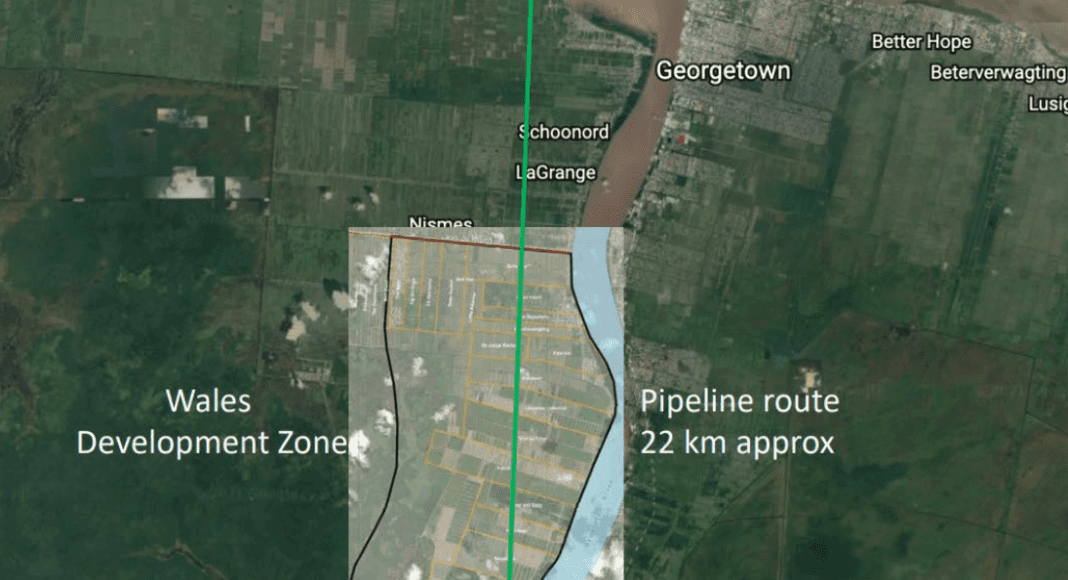Guyana’s Vice President and officials from the Gas to Power Generation Taskforce held a lengthy session with the media on Monday to explain the background and current plans related to the estimated US$900 million project aimed at landing a pipeline from the offshore Liza field and setting up a power generation facility in the new oil producing country. The Ministry of Natural Resources also shared several studies, dating back over the last 5 years, that examined multiple aspects of the project.
“This project has been under study since 2016,” Head of the Gas to Power Generation Taskforce, Winston Brassington, told reporters, pointing out that after the new government was sworn in last August, it started negotiations just two months later with Stabroek block operator ExxonMobil. “By the end of last year, the key decisions were communicated publicly,” he added.
According to the Task Force, over twenty potential locations for landing the pipeline were studied and a thorough evaluation conducted. In the final analysis, two locations were ranked most suitable – Ogle and Wales Industrial Site. Wales was selected due to the low risk of flooding, relatively low cost of land, suitability for planned development, location away from populated centres, the ability to construct the facilities needed, and the overall economics.
“This location was determined as the most economical solution. The selection of the location by the pipeline team is part of the next stage of works, mainly the studies–the environmental studies and the geotechnical and geophysical studies,” Brassington said.
Discussions with Exxon saw an increase in the minimum commitment of gas from 30 million cubic feet (mcf) to 50 mcf, which will see the provision of power increasing from net 150 MW to 250 MW.
“So, the 50 million cubic feet now would allow us to generate 250 megawatts and still have some additional gas that will remain for other purposes that we are hoping to utilize,” Vice President Bharrat Jagdeo explained. “There are currently work done to see maybe urea and some polymers, looking at basalt fiber, looking at protein for the agriculture sector, all of these.”
An agreement was also reached on a timetable to achieve the project by 2024, with the first 18 months being used to complete studies, complete engineering, and conducting a competitive tender for the construction of the pipeline.
“We also reached an agreement on some of the key considerations,” Brassington pointed out. “First, we had an upper limit on the capital cost of the project. Secondly, we agreed that Exxon will fund the pipeline out of cost oil. Thirdly, we had an upper limit of the estimated cost of kilowatt hour of power from gas delivered at the Wales location. That upper limit was three and a half cents per kilowatt hour.”
He said the project was defined to cover not just the gas pipelines but the gas processing facility, which includes the power project, and the layout of the Development Authority to cater for a large expansion covering all aspects of the project plus residential development, mixed use, and industrial demand.
“Now, in the press, many have said there were not studies; it is not true,” the official affirmed. “There have been at least five studies completed between 2016 and 2020.”
The studies he referenced include: Gas to Power Feasibility Assessment in Guyana by K&M Advisors; Oil and Gas Master plan by Japan Cooperation Centre Petroleum Chiyoda Corporation; A Study on System Expansion of the Generation System by Brugman SAS; Desk Study of the Options, Cost, Economics, Impacts, and Key Considerations of Transporting and Utilizing Natural Gas from Offshore Guyana for the Generation of Electricity (2017) by Energy Narrative; Feasibility Study for Guyana’s Offshore Natural Gas Pipeline, NGL Separation and LPG Production plant, and related electricity infrastructure – 2018 by Energy Narrative; and a Feasibility Study for Guyana’s Offshore Natural Gas Pipeline, NGL Separation and LPG Production plant, and related electricity infrastructure – Revised Final Report: Appendix C by Energy Narrative. These studies were all released to reporters on Monday.
“These studies looked at all of the key aspects of the project. And so, a lot of our decisions today are taken in consideration of all of those studies, all of those feasibility studies,” Brassington pointed out.
The Vice President said the key takeaway from all the studies is that the project is financially feasible.
“Even as a layman, when you go through the numbers, you will see if you can have a fixed input, at 3 and a half cents per kilowatt hour, which includes paying back the capital cost for the pipeline and the cost of the gas, when it comes in at 3 and a half cents, fixed for a long period and even going lower once you pay back that pipeline. Compare to 10 cents per kilowatt hour that you are paying now to import fuel that is dirtier and save 150 million dollars by doing this a year—that’s per year, 150 million—then it is financially feasible.”



